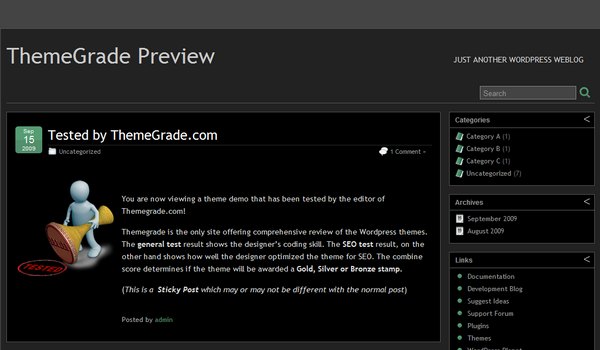Oops! This Theme didn't make the cut and is no longer available. Check our homepage for the latest ThemeGrade of your favorite WP Themes.
Most of the themes are coded using tableless CSS. One of the great benefits of coding using this method is that the code order can be arranged in the way we want.
This is particularly important when it comes to search engine optimization. Similar to the early words in the title tag, the content that is placed higher in the source code weight more in search engines than the content placed in the lower part. It is up to the designers to position different section into the theme code.
How to test?
Step 1
Visit the url of the single post.
Step 2
View the source code of the post.
Step 3
Check the position of the source code for the post content base on the conditions stated below.
Step 4
Repeat step 1-3 for the single page.
Criteria of passing the test
The source code for the post content should be placed right under <body> or under the source code of the header section.

Most designers ignore the W3C test when coding their themes simply because it is a test too tough to pass.
Nevertheless, to comply a theme with W3C is important because of the following benefits:
- Compliance helps the search engine rankings as compare with non-compliant websites. Frederick Townes of W3 EDGE Web Design explained it well when he said, “Proper use of standards and bleeding edge best practices makes sure that not only is the copy marked up in a semantic fashion which search engines can interpret and weigh without confusion, it also skews the content-to-code ratio in the direction where it needs to be while forcing all of the information in the page to be made accessible, thus favoring the content. We’ve seen several occasions where the rebuilding of a site with standards, semantics and our proprietary white hat techniques improves the performance of pages site-wide in the SERPs.”
- Compliance helps ensure that your website is accessible from a number of devices; from different browsers to the growing number of surfers using PDAs and cellular phones.
- Compliance will also help ensure that regardless of the browser, resolution, device, etc. that your website will look and function in the same or at least a very similar fashion.
Exclusion of CSS Validation
We no longer grade themes on whether or not they have valid CSS for a couple reasons. First, certain “hacks” required to make various features function properly in legacy browsers (i.e. Internet Explorer 6-8) are not valid CSS, but are widely considered to be acceptible means of achieving cross-browser styling. Second, with the latest advancements in CSS3 and the way in which various browser vendors impelent these new specs, including one line of browser-specific CSS3 code can lead to validation errors. CSS validation is more or less a good way of spotting errors in a document rather than trying to achieve a “perfect score,” which is very important in terms of markup validation. Hopefully this helps to explain why we no longer apply a grade in this category.
Each and every one of the WordPress theme listed on ThemeGrade has gone through comprehensive tests. The tests cover general coding issues as well as the SEO.
In this post, we outline the tests being used, the weight of each test as well as the calculation details.
General Test
The general tests of a theme give you an idea of how well the designer coded the theme. When pass, the score will be added to the General Test. The tests with the higher score are more difficult to pass than the tests with the lower score.
| Description | Pt(s). | Info | |
|---|---|---|---|
| 1 | W3C Compliant – HTML | 2 | Detail |
| 2 | W3C Compliant – CSS | 2 | Detail |
| 3 | Browser Compatibility – IE7 | 1 | Detail |
| 4 | Browser Compatibility – Firefox | 2 | Detail |
| 5 | Browser Compatibility – Chrome | 1 | Detail |
| 6 | Support from Designer | 2 | Detail |
| 7 | Post area – Proper Image Alignment | 1 | Detail |
| 8 | Post area – Floating Content | 1 | Detail |
| 9 | Post area – Auto Adjustment | 1 | Detail |
| 10 | Post area – Nested/Threaded Comments | 1 | Detail |
| 11 | Sidebar – Link Hierarchy | 1 | Detail |
| 12 | Sidebar – Auto Adjustment | 1 | Detail |
| 13 | Special Effect | variable | Detail |
| Total Points | 16 + variable | ||
If a theme passes all general tests, the theme will score 100%.
In all cases, a theme will be tested against the first 6 general tests.
For most of the times, a theme will be tested against the first 11 general tests.
Calculation method of the General Test.
- Step 1 – Find out how many items a theme has been tested on.
- Step 2 – Add the total score of the tested items
- Step 3 – Add the total score of the passed items
- Step 4 – Take the score of the tested items and divide it by the score of the passed items. Multiply that number with 100 to get the percentage score of the theme.
SEO Test
WordPress does a very good job in internal linking so that makes it easy for search engines to index the pages. To rank for the pages, generally, two main factors are considered: on-page optimization and off-page optimization.
The off-page optimization is relating to external links and it has nothing to do with the theme itself. To see if a theme is optimized for search engines, we need to review the theme coding (on-page optimization).
The SEO tests of a theme give you an idea of how well a theme had been optimized for search engines.
When pass, the score will be added to the SEO Test. The tests with the higher score are more difficult to pass than the tests with the lower score.
| Description | Pt(s). | Info | |
|---|---|---|---|
| 1 | W3C Compliant – HTML | 1 | Detail |
| 2 | W3C Compliant – CSS | 1 | Detail |
| 3 | Home page Heading SEO | 1 | Detail |
| 4 | Post & Page Heading SEO | 1 | Detail |
| 5 | Post & Page Title Tag (Title as seen in SERPs) | 1 | Detail |
| 6 | Content Code Position | 2 | Detail |
| Total Points | 9 | ||
Calculation method of the SEO Test is the same as the General Test.
Calculation of the total score of a theme
General Test Score x 0.6 + SEO Test Score x 0.4




